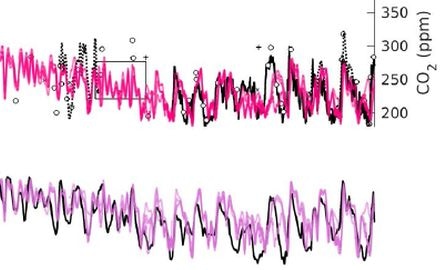Apr 4 2019
Present levels of CO2 greenhouse gas in the atmosphere are probably higher than they ever were in the last three million years.
 Transient modeling results: Atmospheric CO2 concentration (in pink) compared to ice core data (solid line) and other proxies. Cutout from figure 2 of Willeit et al, 2019. (Image credit: Potsdam Institute for Climate Impact Research)
Transient modeling results: Atmospheric CO2 concentration (in pink) compared to ice core data (solid line) and other proxies. Cutout from figure 2 of Willeit et al, 2019. (Image credit: Potsdam Institute for Climate Impact Research)
A team of researchers, for the first time, have successfully carried out a computer simulation that is in agreement with ocean floor sediment data of climate evolution over this time period. The research shows that a reduction in CO2 levels chiefly triggered ice age onset, and hence the commencement of the glacial cycles from cold to warm and back. However, the analysis further proves that presently, the increase in greenhouse gases caused by the burning of fossil fuels is essentially changing the earth.
The research reveals that, over the last three million years, global mean temperatures never crossed the preindustrial levels by above 2 ○C; however, if current climate policy inaction is continued, then the global mean temperatures would go beyond the 2 degrees limit already in the next five decades.
We know from the analysis of sediments on the bottom of our seas about past ocean temperatures and ice volumes, but so far the role of CO2 changes in shaping the glacial cycles has not been fully understood. It is a breakthrough that we can now show in computer simulations that changes in CO2 levels were a main driver of the ice ages, together with variations of how the Earth’s orbits around the sun, the so-called Milankovitch cycles. These are actually not just simulations: we compared our results with the hard data from the deep sea, and they prove to be in good agreement. Our results imply a strong sensitivity of the Earth system to relatively small variations in atmospheric CO2. As fascinating as this is, it is also worrying.
Matteo Willeit, Study Lead Author, Potsdam Institute for Climate Impact Research
The study was recently published in Science Advances.
The key to understanding potential future pathways of humanity is analyzing Earth’s past and its natural climate variability. “It seems we’re now pushing our home planet beyond any climatic conditions experienced during the entire current geological period, the Quaternary,” says Willeit. “A period that started almost 3 million years ago and saw human civilization beginning only 11,000 years ago. So, the modern climate change we see is big, really big; even by standards of Earth history.”
Learning from Earth’s Past to Understand the Future
The scientists utilized the previous research at PIK to reproduce the key characteristics of natural climate variability in the last few million years with an efficient numerical model—a computer simulation based on astronomical and geological data and algorithms denoting the chemistry and physics of earth.
The simulation was enabled only by recognized variations in the ways the Earth revolves around the sun, the so-called orbital cycles, and various scenarios for gradually changing boundary conditions, for example, CO2 outgassing from volcanoes. Furthermore, the study explored variations in sediment distribution of the Earth surface, as ice sheets slither more easily on gravel than on bedrock. In addition, it has explained the role of atmospheric dust, which causes the ice surface to turn darker and thus contributes to melting.
The fact that the model can reproduce the main features of the observed climate history gives us confidence in our general understanding of how the climate system works. The simulations we develop have to be simple enough to allow for thousands of calculation runs of many thousands of years, and yet have to capture the critical factors that drive our climate. This is what we have achieved. And it is confirming how outstandingly important changes in CO2 levels are for Earth’s climate.
Andrey Ganopolski, Study Co-Author, Potsdam Institute for Climate Impact Research
Andrey Ganopolski is also the author of many previous revolutionary studies upon which the new analysis is now built.